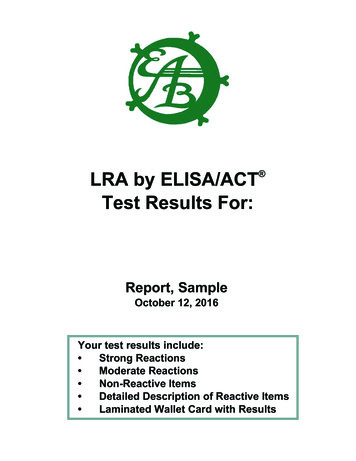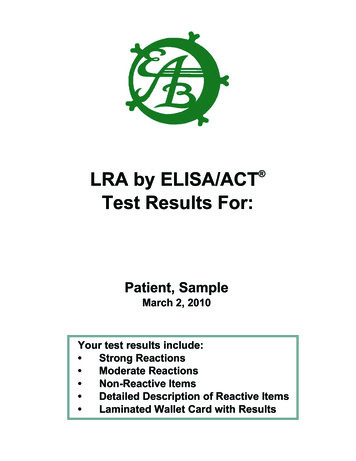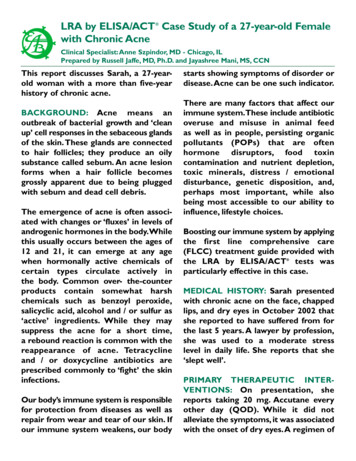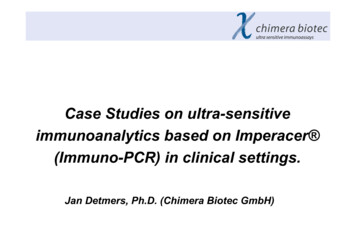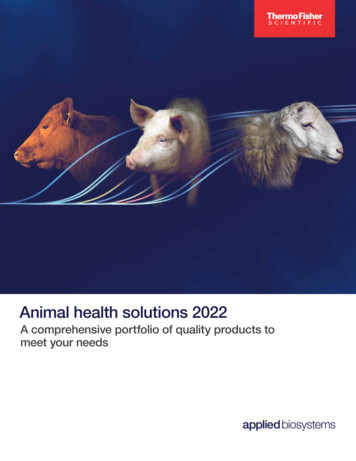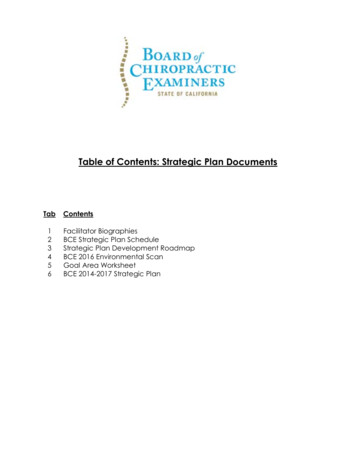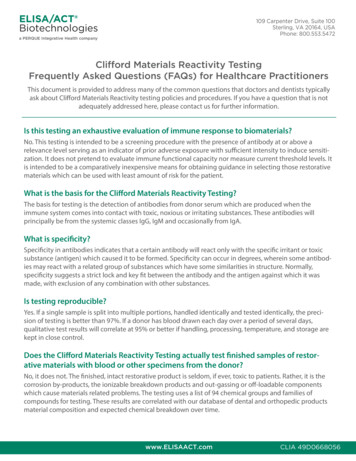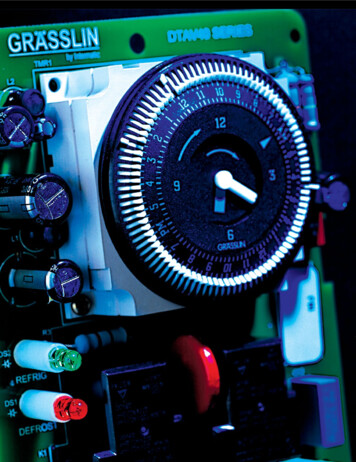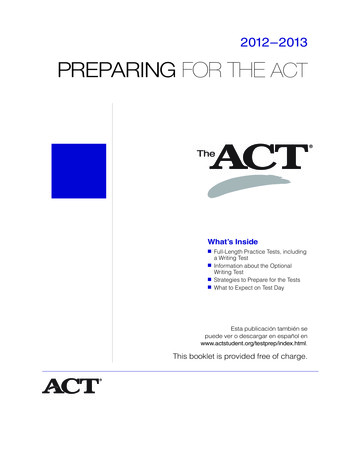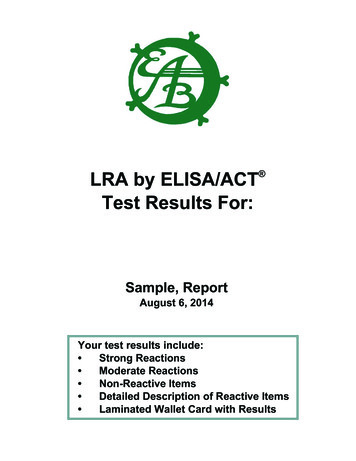
Transcription
LRA by ELISA/ACT Test Results For:Sample, ReportAugust 6, 2014Your test results include: Strong Reactions Moderate Reactions Non-Reactive Items Detailed Description of Reactive Items Laminated Wallet Card with Results
ELISA/ACT LRA RESULTSSTRONG REACTIONSSample, Report 72287August 6, 2014Avoid for at least 6 months. Potato, White Spinach Whey Gum, Acacia Mannitol FD&C Yellow #5STRONG FOOD GROUP(S): NIGHTSHADESEggplantGoji BerryPepper, CayennePepper, ChiliBell Pepper, All ColorsPotato, WhiteTobaccoTomatoPaprikaPimiento COW DAIRYButter (Whole)Cheese (Cow):BrickCottage CheeseParmesanProcessed CheeseLactalbuminLactoglobulinMilk (Cow):CaseinMilk, PasteurizedMilk, RawYogurtWheyMODERATE REACTIONSAvoid for at least 3 months. Bean, Lima Pepper, Chili, Red Acai Berry Potassium sorbate FD&C Red #2 FD&C Yellow #10 Cadmium Polyvinylpyrrolidone Pyrene Echinacea Aspirin/Coal TarThus of the 504 substances tested, reaction is noted to 17 items and 2 food group(s).While both strong and moderate reactions are equally burdensome to your immunedefense and repair systems, we have found that it takes about half as long to restoretolerance of moderate reactions as compared to the strong ones.Results1A
Sample, Report8/6/201472287ELISA/ACT LRA RESULTSNON-REACTIVE ITEMS 1, 2 Dichlorobenzene 2-Methyl Pentane 2, 4, 5 T 2,4-D 3-Methyl Pentane Acesulfame Aduki/Adzuki Bean Agave nectar Aldrin Alfalfa Algae (Chlorella) Algae (Spirulina) Allspice Almond Aloe Alternaria alternata Aluminum Amaranth Amitriptyline (Elavil) Amoxicillin Ampicillin Anchovy Anise Seed Annatto Antimony Apple Apricot Arnica Arrowroot Arsenic Artemisia anua Artichoke Asparagus Aspartame/Nutrasweet Aspergillus fumigatus Aspergillus niger Aspergillus oryzae Astragalus Avocado Baking Powder Bamboo Banana Barium Sulfate Barley Basil Bass Bay Leaf Bean, Garbanzo Bean, Kidney Bean, Mung Bean, Navy/Ninja Bean, Pinto/Frijole Bean, Soya Bean, String/Wax Beef/Veal Beet Benzaldehyde Benzene Benzopyrene Benzyl Acetate Bergamot Beryllium Oxide BHA BHT Black Cohash Blackberry Bladderwrack Blueberry Bok Choi Botrytis cinerea Boysenberry Brazil Nut Brilliant Black Broccoli Buckwheat/Kasha Buffalo Butter, Clarified (Ghee) Cabbage/Brussels Sprouts Caffeine Calcium Propionate Camphor Camu Camu Candida albicans Cantaloupe/Honeydew Caraway Seed Carbamates Carbon Disulfide Carbon Tetrachloride Cardamom Carmine/Cochineal Carmoisine Carob Carrot Cashew Cassava (Yuca) Cat Dander (Felis cattus) Catfish Cauliflower Celery Cellulose/Hemicellulose Cephalexin (Keflex) Chamomile Chard Cheese, Romano (Sheep) Cheese/Milk (Goat) Cherry Chestnut Chia Chicken Chicory Chinese Tea Chive Chlordane Chloroform Chocolate/Cocoa Chrysanthemum Cilantro Cinnamon Ciprofloxacin (Cipro) Cis-Dichloroethylene (1, 2 Cladosporium cladosporioides Cladosporium herbarum Clam Clarithromycin (Biaxin) Clove Coconut Cod Liver Oil Codfish Coffee, Decaf & RegResults1B
ELISA/ACT LRA RESULTSSample, Report8/6/201472287NON-REACTIVE ITEMS, CONT'D Cola Collard Greens Coriander Corn (Maize) Cottonseed Oil Crab Cranberry Cream of Tartar Cucumber Cucumber, Japanese Cumin Currant Curry Cyclohexylamine D & C Green #5 D & C Orange #5 D & C Red #33 D & C Violet #2 D&C Orange #4 Date DBCP (1,2 Dibromo-3-chloropropane) DDT Deer/Venison DEET Detergent (Synthetic) Diacetyl (2,3-Butanedione) Diazepam (Valium) Dibutyl Phthalate Dieldrin Dill Docosanol (Abreva) Dog Dander (Canis familiaris) Dong Quai Dragon Fruit Duck Feathers (Anas platyrhynca) Duck/Goose Dulse EDTA Egg White (Chicken) Egg Yolk (Chicken) Elderberry Endive Endrin Ephedra Epidermophyton floccosum Erythromycin Ethyl Acetate Ethyl Acetoacetate Ethyl Butyrate Ethyl Mercury Ethylene Dibromide FD&C Blue #1 FD&C Blue #2 FD&C Green #3 FD&C Red #3 FD&C Red #40 FD&C Yellow #6 Feverfew Fig Flaxseed/Linseed Oil Fluconazole (Diflucan) Formaldehyde Fusarium solani Fusarium vasinfectum Garlic Gelatin Geotrichum candidum Gin (Juniper Berries) Ginger Ginseng, American Ginseng, Chinese Ginseng, Siberian Gliadin Gluten Goat Hair/Skin Scraping (Capra hircus) Gold Goldenseal/Hydrastis Goose Feathers (Anser anser) Gooseberry Grape Seed Oil Grape/Raisin, Green Grape/Raisin, Red Grapefruit Guaifenesin (Mucinex) Guinea Pig Hair (Cavia porcellus) Gum, Agar Gum, Carrageenan Gum, Guar Gum, karaya Gum, Locust Bean Gum, Tragacanth Gum, Xanthan Haddock Halogenated Biocide Hawthorne Hazelnut/Filbert Helminthosporium halodes Helminthosporium sativum Hemp Heptachlor Hexachlorocyclohexane Hijiki Honey Hops Horse Dander (Equus caballus) Horseradish Hydrogenated Oil Hydroxychloroquine (Plaquenil) Hypericum/St. John's Wort Ibuprofen Irish Moss Isopropyl Ether Kale Kamut Kelp/Sea Weed Kiwi Kombu Lamb/Mutton Latex Lead Leek Lemon Lemongrass Lentils, Red, Green Lettuce, Iceberg Lettuce, Red Leaf Lettuce, Romaine Licorice LimeResults2B
ELISA/ACT LRA RESULTSSample, Report8/6/201472287NON-REACTIVE ITEMS, CONT'D Lobster Lomatium Maca Macadamia Mace Magnesium stearate Maleic Anhydride Malt Mango Marjoram Menthol Mercury Mesalamine (Asacol) Metallic Catalysts Methoxychlor Methyl Mercury Methyl paraben Methylene Chloride (Dichloromethane) Methylphenidate (Ritalin) Millet Miso, Barley Miso, Brown Miso, Hatcho Miso, White Molasses Morpholine MSG (Monosodium Glutamate) Mucor mucedo Mucor racemosus Mushroom Mushroom, Maitake Mushroom, Reishi Mushroom, Shiitake Mustard Greens, Spice Naproxen Nectarine Nickel (II) Chloride Nitrates/Nitrites Nitrosamine Mix Noni Nutmeg Nystatin Oats Okra Olive Omeprazole (Prilosec) Onion, Yellow Orange Oregano Organophosphates Oyster Palm Oil Papaya Parsley Parsnip Pea, Black-Eyed Pea, Green, Snow Peach Peanut Pear Pecan Penicillamine Penicillin Penicillium frequentans Penicillium notatum / chrysogenum Penicillium roqueforti Pentachlorophenol (PCP) Pepper, Black Pepper, White Peppermint Perch/Mackerel Petroleum By-Products & Solvents Phenol Phthalates Pineapple Pinene Piroxicam (Feldene) Pistachio Plum, Umeboshi Plum/Prune Polyethylene glycol Polysorbate 20 Polysorbate 60 Polysorbate 80 Pomegranate Ponceau 2R Ponceau 4R Poppy Seed Pork/Bacon/Ham Potassium Bromate Potato, Sweet Primrose Oil Propyl Gallate Propyl paraben Propylene Glycol (1,2-Propanediol) Psyllium Seed Pullularia pullulans Pumpkin Quail Quinoa Rabbit Rabbit Hair (Oryctolagus cuniculus) Radish Rapeseed/Canola Oil Raspberry Resin Rhizopus nigricans / stolonifer Rhodotorula Rhubarb Rice, Basmati Rice, Brown Rice, White Rice, Wild Rose Hips Rosemary Royal Jelly Rutabaga Rye Saccharine Safflower Oil Saffron Sage Salicylate Salmon/Lox Sardine Scallion/Spring Onion Scallop Sea Lettuce Selenium SulfideResults3B
ELISA/ACT LRA RESULTSSample, Report8/6/201472287NON-REACTIVE ITEMS, CONT'D Sesame/Tahini Sheep Wool (Ovis aries) Shrimp Silicates / Silicon Dioxide Silicone Silver Slippery Elm Snapper Soap (SDS/SLS) Sodium alginate Sodium Benzoate Sodium erythorbate Sodium Fluoride Sodium Propionate Sole/Flounder/Halibut Sorbitol Spearmint Spelt Splenda (sucralose) Squash Star Fruit Stevia Strawberry Streptomycin Sugar Cane / Sucanat Sugar, Beet Sugar, Corn Sugar, Maple Sulfite/Metabisulfite Sunflower Swordfish Tamari Tamarind Tangerine/Mandarin Orange Tapioca Tarragon Tea, Black Tert-Butyl-Ethyl Ether (TBEE) Tert-Butyl-Methyl Ether (TBME) Tetrachloroethylene Tetracycline Thricothecium roseum Thyme Tilapia Tin/Stannous Chloride Titanium Dioxide Tofu Toluene Trichloroethylene (TCE) Trichoderma harzianum Trichophyton mentagrophytes goetzii Trichophyton mentagrophytes interdigitale Trichophyton rubrum Trichophyton schoenleinii Triticale Trout Tuna Turbot/Whitefish Turkey Turkey Feathers (Meleagris gallopavo) Turmeric Turnip, Greens Tylenol (Acetaminophen) Valerian Vanilla Vegetable Glycerin Vinyl Chloride Wakame Walnut Oil, Black Walnut, English Water chestnut Watercress Watermelon Wheat White Willow Bark Xylene Xylitol Yaki Nori/Laver Yeast, Baker's (S. cerevisiae) Yeast, Brewer's (S. cerevisiae) Yerba MateResults4B
Sample, Report 72287August 6, 2014LRA by ELISA/ACT Tests Results and What They MeanLRA by ELISA/ACT tests use a breakthrough technology that allows the laboratory, for the first time, to observeimmune reactions of specialized white cells (lymphocytes) just as they occur in your body (ex vivo, to be technical).Live lymphocytes from your blood sample are exposed to antigens in our lab. Reaction indicates loss of tolerance anddevelopment of self-attack known as delayed hypersensitivity. Strong reaction means that 50% of cultured lymphocytes react. Moderate reaction means that 5-50% of cultured lymphocytes react.Complete food group(s) will be displayed as reactive when two or more foods in that group are reactive. Dairy, because itis commonly cross-allergenic, is the only exception. The dairy group will appear in bold if even one item in the dairygroup is reactive. It is recommended to avoid all items in a food group if it is listed in bold.Reactive items are an adverse load on your body’s immune defenses. This means a reduced ability to respond to new orchronic infections. Reactive items also decrease immune activities needed to repair your body. This can provokeinflammation and self-attack ("autoimmunity").Avoid strong reactors for six (6) months and moderate reactors for three (3) months to reduce the burden on theimmune system and restore your body’s ability to repair. Avoiding reactive items can break the cycle of impaired defenseand repair, allowing your body to start the recovery and repair process.Immediate allergies (Type 1 IgE linked) are not detected by the LRA by ELISA/ACT tests. Immediate allergies areusually detected by history, routine skin tests, or RAST tests. If you have known immediate allergies, you should continueavoiding those items. Consult with your health professional if you have any questions regarding your immediateallergies.LRA by ELISA/ACT Tests Are DifferentThe LRA tests identify only reactive lymphocytes. B class lymphocytes react to harmful antibodies; T classlymphocytes react directly.Protective memory (non-reactive IgG) antibodies do not provoke symptoms and are not detected by ELISA/ACT LRAtests. Detecting only the items that provoke reactions is an advantage of lymphocyte response assays.Other antibody tests (ELISA IgG, EIA IgG, IgG tests) do not offer this advantage. These tests measure only if antibodiesare present. Since antibodies can be helpful or harmful, knowing the amount of an antibody tells nothing of its function-does it protect and help or does it react and harm?Some labs measure particles and assume all particles of a certain size are reactive lymphocytes—again, thesemeasurements are not as helpful as the LRA by ELISA/ACT tests.MD, Ph.D., FASCP, FACAAI, FACNReferences: Golub, E.S. Immunology: A synthesis Sinauer Associates, Inc. , Sunderland, MA 1987 p474-479. Sell, S. Immunology,Immunopathology, and Immunity, 4th Ed., Elsevier, NY, 1987 p 314-321. Jaffe, R. Improved Immune Function Using Specific NutrientSupplementation and ELISA/ACT “Immunologic Fingerprint” to Detect Late Phase Responses Ex Vivo. J Am Col Nutr 8(5): 424, 1989.
Sample, Report 72287NameAmountNutritional RecommendationsTimes8/6/2014Action/UseSpecial CommentPriority Supplements:PERQUE LIFETwo tabsulesGUARD Multivitaminmultimineral/transporter enhanced w/oironPERQUEPotent CGUARDAscorbate(buffered Vitamin C)Powder or tabletsTwice a day with Provides essential vitamins and minerals inmeals of choice. the most bio-absorbable and bio-availableTotal of 4forms, for optimal metabolic functioning .Depends on amount Four or morebody will absorbtimes a day(determined by theAscorbate calibrationprotocol)Energizing and alkalinizingformula : enhances andprotects the immune systemCentral regulator of cell metabolism, astimulant to structural connective proteinsynthesis, & is vital to repairRefer to the Ascorbate(Vitamin C) Calibrationprotocol that will helpdetermine the body's needfor Vitamin C . This is alsoon Page 93 in The AlkalineWay GuidePERQUE PAIN6 tabsulesGUARD FORTÉ,500mg. Quercetin with 5mg. of (OPC soluble)ProanthocyanidinsTwice a day ;total of 12This flavonoid and flavanol combinationimproves utilization of Vitamin C; reduceschronic viral activity and decreasesinflammation.Best taken in conjunctionwith ascorbate.PERQUE DIGESTA 1-2 capsulesGUARD FORTÉ 10 1-2 capsules(Synergy of 101 capsulebeneficial probiotics)With all mealsfor 3 monthsWith breakfastand dinner : for6 months.With breakfastonly, after 9monthsRebuilds healthy digestive flora in theintestinal tract. Inhibits the growth ofpathogens . Promotes better overalldigestionAfter 6 months from start oftherapy a stool culture ofmicroflora (intestinal bugs)is recommended. Pleasesee your healthcareprofessional to obtain furtherinformation.PERQUE LIVA3 capsules a dayGUARD ( Promotesliver health: uniqueantioxidant complex )Twice a dayHelps restore liver function.Use for 3 months andrecheck liver enzymeactivity.Oral Vitamin B12 as 1 sublingual lozenge 5 times a dayhydroxocobalaminfor energy anddetoxificationImproves methylation detoxification andHydroxocobalamin is thereduces cell susceptibility to stress injury.preferred form of B-12 andAlso, improves transport of biochemicals and is suitable for vegetarians. Ifreduces reactivity of muscle fibers. Besthomocysteine levels aredissolved under the tongue, not swallowed. monitored, sufficient intaketo reduce levels 6 mg/dl isrecommended.Supplements1
Sample, ReportNameNutritional RecommendationsAmountTimesAction/UseSpecial CommentSpecific supplements that may be helpful:PERQUE BONE4-6 TabsulesGUARD FORTÉ 20( Ultimate boneprotection)Divided through Alkalinizing bone building formula with 20For best absorption, includethe day :nutrients including minerals and associated a bed time doseMaximum of 6 cofactorsPERQUE CHOLINE 1300 mg. (1CITRATE ( uniqueteaspoon) diluted inliquid performance- juice or waterenhancing formulafor body and mind)Breakfast &dinner.Improves cell membrane communication&bile acid production.Choline citrate is fivefoldmore active than cholinebitartrate.Choline Bitartrateis also likely to be antigencontaminated,PERQUE MITOGUARD PLUSCoenzyme Q10micellized with purerice bran oil300 mg.Once a dayImproves cell electron transport andincreases energy production in the cell.Improves heart /musclehealth and energyPERQUE TRIPLEEFA GUARDEssential FatsOmega 3,6,9 DHAEPA CLA2 softgelsThree times aday : total of 6Omega 3 reduces plaque formation.Omega 6 decreases inflammationOmega 9 enhances membrane fluidity.Essential Fatty Acids in theright proportions forimproved healthPERQUE2 softgelsMETABODETOXPLUS GUARDEnhanced fatmetabolizers:Carnitine fumarateMCT, GABA & KelpAlginate4 times a day :Total of 8Provides effective fat metabolism; givesexercise benefits; controls appetite. Alsoimportant for heart muscle functionThis is a potent formula,with convenient dosage andlasting resultsPERQUE3 capsulesENDURA/PAKGUARD L-Glutamine PyridoxylAlphaketoglutarate("PAK")Three times adayGives body energy, supports mentalsharpness, helps regenerate the intestinalsurface cells.PAK recycles L -glutamineand prevents glutamate build up.Take on empty stomach, i.e1/2 hour before a meal / 2hours after meals or atbedtimeSupplements2
Sample, ReportNameNutritional RecommendationsAmountTimesAction/UseSpecial CommentPERQUE DETOX IN Two tabsulesGUARDLipotropic/AminoacidBlend :NeuroimmunedetoxifierTwice a day :Sulfur and cyclic amino acids help the body Energizing and alkalinizingtotal of 6to build proteins, improve metabolism andformula helps cells support30 to 60 minutes aids in detoxification. Lipotropic factors aid in optimal healthbefore eating.fat metabolism, building cell membranes,( emptyand improving bile itratecombination :Complete immunesystem support.Once a day with Essential for immune function, enhancesmeal of choice. tissue repair, maximizes chemicaldetoxificationZinc Picolinate/Citrate formsare most easily assimilated.Vitamin B6 in the formulaaids in optimal zincabsorptionPERQUE ADRENO 2 soft gelsDISTRESS GUARD:Nature'scomprehensivestress relief :Rhodiola, Magnoliaand PhellodendronTwice a dayNeutralizes stress, balances cortisol andrebuilds hormone functionStore product below 70 F.PERQUE GLUCOSE 2 softgelsREGULATIONGUARD :Naturalinsulin/sugarregulation :Three times aRegulates blood sugar levels and energyday with meals: balance , decreases insulin resistance,Total of 6decreases hormonal dysregulationLowers body weight whileincreasing lean body massLiquid Nutrient PlanUp to full amount tofeel satisfied.One day eachweekPanax GinsengextractOne ampule1/2 hour before Enhances adaptation to distress.lunch.1 tabsuleCharcoal capsules or 1 or 2 capsules ortabletstablets.Provides easily assimilated nutrients withRefer to the Liquids-Onlyminimum work by digestive system, so repair Nutrient Sufficiency Plan :can occur.page 89 in The AlkalineWay Guide for moreinformationAfter breakfast, Absorbs excess formed gas.lunch, dinner. Asneeded for gas.Take after meals only ifneeded for 'gas control'.Supplements3
Sample, Report 72287Behavioral Recommendations8/6/2014Learn new patterns of consumption. You may want to read Diet for a Small Planet by Frances Moore Luppe, Diet andNutrition by Rudolph Ballantine, MD., Minding the Body, Mending the Mind by Joan Borysenko, PhD., and Acid andAlkaline by Herman Aihara.Take balanced and fully active nutritional supplements as recommended in this report. Your health professional, orthe sources cited in this report, can provide ordering information.Demonstrate your commitment to your health as an essential part of your life by performing each and every part ofthis report as recommended by your physician with full attention.Learn abdominal breathing and practice it for a few minutes once or more each day. Abdominal breathing meansactively filling the abdomen as though it were a balloon being filled. Next allow the balloon to slowly passively deflate.Repeat for the full five minutes twice daily.Discuss the meditation technique that is best for you with your doctor. Active Meditation: the Western Tradition byRobert R Leichtman, MD and Carl Japikse is an example of a non-sectarian, non-denominational approach to evokingyour healing response, and is distinctly helpful.Combine foods according to Food Combining for Better Digestion in order get the most efficient assimilation ofnutrients from the foods you eat. This is Page 19 in the Alkaline Way Guide.Have your digestion evaluated by a Comprehensive Stool Analysis.Use special, biologically active dichromatic green lights. These are known as PAR38 ( 150 watt green) and are madeby GE and Sylvania. These are available from Thinking of You at 800-806-8671. Direct the light at the face from adistance of about 5 feet for about 20 minutes daily: before bed and on rising are particularly good times. Refer to LightTherapy: Page 109 in the Alkaline Way Guide.Exercise using the rebounder-type trampoline for 15 minutes twice a day . Rebounder-type trampolines can bepurchased at your local sporting goods store. Refer to Distress Busting: Central Health Promoting Actions Rebounder Trampoline: Page 106 in The Alkaline Way GuideTake a daily salt and soda bath. The Epsom salt ( Magnesium Sulfate) electrolyte improves the electrical conductivityof the skin and the alkaline baking soda helps rid the skin of acid residue deep in the pores. Put one half cup each ofEpsom salts and baking soda in a tub of warm (not hot) water. Soak for 10-15 minutes and shower thereafter, gentlyrubbing the skin with a loofa. Refer to Distress Busting: Central Health Promoting Actions - Salt and Soda Baths formore information: Page 91 in The Alkaline Way GuideReceive traditional acupuncture [6-8 sessions to determine effectiveness] from a traditional acupuncturist near you.Ask your physician for a referral.Healthy Habits1
Sample, Report 72287Description of Items:August 6, 2014Potato, WhiteHistory/Discussion:White Potato(Solanumn Tuberosum L) is a member of the Solanaceae ( Nightshade ) family.Plants in the Nightshade family contain, to varying degrees, chemical compounds (alkaloids called solanins) withpharmacological and toxic effects. This family contains some toxic, as well as some food plants. Also included in thenightshade family is poison sumac. All nightshade foods contain some solanins; sumac contains the most. Othercommon members of this family include tomatoes and bell peppersSources of Exposure: Potatoes can be used as chips, in casseroles, stews, baked goods such as pies and bread.Potatoes can also be used as a filler or thickener in soups, desserts and gravies.If you are reactive to two or more items in the nightshade family we recommend you avoid all the items in this familybecause the chance of cross-reactivity and/or developing new sensitivities is great.If potato is reactive, all potatoes (except sweet potatoes or yams) and items containing potato starch and/or flour shouldbe avoided.Substitutions: Any of the non-reactive vegetables.SpinachHistory/Discussion: Spinach is a very popular green leafy vegetable.Sources of Exposure: Soups, casseroles and other processed foods (check labels).Substitutions: Other leafy vegetables such as collard greens or mustard greens (assuming you do not react to them).Note: Avoidance of specific foods to which you react is sufficient. There is no added benefit in avoiding a completefood family unless specifically directed to.1
Sample, Report 72287Description of Items:August 6, 2014WheyDescription:Whey is one of the 2 major proteins in milk. It is a by-product of cheese making and is formed when the curds separatefrom the milk or cream. In this curdling process, when rennet or an edible acidic substance is added to milk, cheesecurds are formed, and the remaining liquid is called whey. This liquid is watery and thin.Other names:Bovine Whey Protein Concentrate, MBP, Milk Protein, Milk Protein Isolate, Mineral Whey Concentrate, Whey, WheyFraction, Whey Peptides, Whey Protein Concentrate, Whey Protein Hydrolysate, Whey Protein Isolate.Sources of exposure:Whey is used to produce some cheeses like ricotta, brown cheeses, Gjetost and Messmör/Prim. It is also an additive inmany processed foods, including breads, crackers and commercial pastry. Whey protein is of very high biological valueand used in powders and bars for improving athletic performance and body building. It is also used as a nutritionalsupplement in weight management programs and sometimes as an alternative to milk for people with lactoseintolerance, In Switzerland, where cheese production is an important industry, whey is used as the basis for acarbonated soft drink called Rivell.Note: If you are COW DAIRY sensitive, you must avoid whey.Alternatives:Other healthy non – sensitive protein sources e.g egg, soy, rice and fishGum, AcaciaItems Tested: Acacia is the odorless, colorless, tasteless dried exudate from the stem of the acacia tree grown in Africa,the Near East, India and the southern United States. Unlike many other natural gums, it dissolves easily in water.History/ Discussion: Also called gum arabic, this substance has many uses as a emulsifier, flavoring agent, thickener,processing aid and stabilizer in beverages, and dessicant. For example, it is an emulsifier typically used in saladdressings, particularly when they contain oil and water. It is derived from a natural product, and no clearly defined healtheffects have been reported. However it can be irritating to the eyes, nose, and respiratory tract.Sources of Exposure: A principal use of acacia is the confectionary industry where it is used to retard sugarcrystallization and as a thickener for candies, jellies, glazes, beverages, fillings, frostings, gelatins, and chewing gum. Itis also used in cough drops and dairy products analogs. It is used as a foam stabilizer in the soft drink and brewingindustries and as mucilage to give form to tablets. Arabic gum is permitted as an "optional ingredient" in standardizedfoods and thus does have to be listed as an ingredient on the label.Substitutions: Home-made, farm-made, and organically-certified, full disclosure labels can avoid 'hidden' acacia. Whenin doubt, don't use a product.2
Sample, Report 72287Description of Items:August 6, 2014MannitolItem Tested: Mannitol is an organic compound with the formula (C6H8(OH)6). This polyol is used as an osmotic diureticagent and a weak renal vasodilator. It was originally isolated from the secretions of the flowering ash, called manna aftertheir resemblance to the Biblical food, and is also referred to as mannite and manna sugar. Mannitol is a sugar alcohol;that is, it is derived from a sugar by reduction. Other sugar alcohols include xylitol and sorbitol.History/Discussion: Mannitol is used clinically to reduce acutely raised intracranial pressure until more definitivetreatment can be applied, e.g., after head trauma. It is also used to treat patients with oliguric renal failure.Mannitol can also be used to open the blood-brain barrier by temporarily shrinking the tightly coupled endothelial cellsthat make up the barrier. This makes mannitol indispensable for delivering various drugs directly to the brain (e.g., in thetreatment of Alzheimer's disease). Mannitol is commonly used in the circuit prime of a heart lung machine duringcardiopulmonary bypass. The presence of mannitol preserves renal function during the times of low blood flow andpressure, while the patient is on bypass. The solution prevents the swelling of endothelial cells in the kidney, which mayhave otherwise reduced blood flow to this area and resulted in cell damage.Mannitol is also being developed by an Australian pharmaceutical company as a treatment for cystic fibrosis andbronchiectasis and as a diagnostic test for airway hyperresponsiveness. The mannitol is orally inhaled as a dry powderthrough what is known as an osmohaler and osmotically draws water into the lungs to thin the thick, sticky mucuscharacteristic of cystic fibrosis. This is intended to make it easier for the sufferer to cough the mucus up duringphysiotherapy. The critical characteristic of the mannitol is its particle size distribution.Mannitol is also the first drug of choice for the treatment of acute glaucoma in veterinary medicine. It dehydrates thevitreous humor and, thus, lowers the intraocular pressure. However, it requires an intact blood-ocular barrier to work.Mannitol can also be used to temporarily encapsulate a sharp object (such as a helix on a lead for an artificialpacemaker) while it is passed through the venous system. Because the mannitol dissolves readily in blood, the sharppoint will become exposed at its destination.Mannitol may be administered in cases of severe Ciguatera poisoning. Severe ciguatoxin, or "tropical fish poisoning"can produce stroke-like symptoms.Mannitol is the primary ingredient of Mannitol Salt Agar, a bacterial growth medium, and is used in others.In oral doses larger than 20 g, mannitol acts as an osmotic laxative, and is sometimes sold as a laxative for children.Sources of exposure (additional): Mannitol is also used as a sweetener for people with diabetes, and in chewing gums.Since mannitol has a positive heat of solution, it is used as a sweetener in "breath-freshening" candies, the coolingeffect contributing to the fresh feel. The pleasant taste and mouthfeel of mannitol also makes it a popular excipient forchewable tablets.3
Sample, Report 72287Description of Items:August 6, 2014FD&C Yellow #5Item Tested: FD&C Yellow #5 food color is also known as Tartrazine, Acid Yellow or Lemon Yellow.History/Discussion: FD&C Yellow # 5, or Tartrazine, is bright orange-yellow powder which is freely soluble in water.FD&C Yellow # 5 is one of the most widely used color additive in food, drugs, and cosmetics. Originally a coal-tarderivative, it is a pyrazole coloring agent. FD&C Yellow # 5 has provoked asthma in some individuals and may causehives in some patients. In particular it can cause allergic reactions in persons sensitive to aspirin. Some aspirinsensitive patients have been reported to develop life-threatening asthmatic symptoms upon ingestion of this coloring.The FDA requires labeling of FD & C Yellow # 5 in food, drugs and cosmetics.Sources of Exposure: FD&C Yellow # 5 is used in some prepared breakfast cereals, imitation strawberry jelly, bottledsoft drinks, gelatin desserts, ice cream, sherbets, custards, dry drink powders, candy, confections, bakery products,preserves, spaghetti and puddings. Also used as a coloring in hair rinses, hair-waving fluids, and in bath salts. FD&CYellow # 5 is also used as a dye for wool and silk. Efforts were made to ban this color in over-the-counter pain relievers,antihistamines, oral decongestants, and prescription anti-inflammatory drugs. It is still available in these products,however.Substitutions: Any of the non-toxic natural colors from food and/or plants.NIGHTSHADESItems Tested: There is a family of plants called the Solanaceae family or nightshades. Eggplant, bell peppers, chili peppers, gojiberries, paprika, white potato, tobacco, and tomato are members of this nightshade family tested.History/Discussion:Plants in this family contain, to varying degrees, chemical compounds (alkaloids called solanins) with pharmacologic and toxiceffects. This family contains some toxic, as well as some food plants. Also included in the nightshade family is poison sumac. Allnightshades contain some sol
ELISA/ACT LRA RESULTS August 6, 2014 Sample, Report 72287 STRONG REACTIONS Avoid for at least 6 months. Potato, White Spinach Whey Gum, Acacia Mannitol FD&C Yellow #5 STRONG FOOD GROUP(S): NIGHTSHADES Eggplant Goji Berry Pepper, Cayenne Pepper, Chili Bell Pepper, All Colors Potato, White
